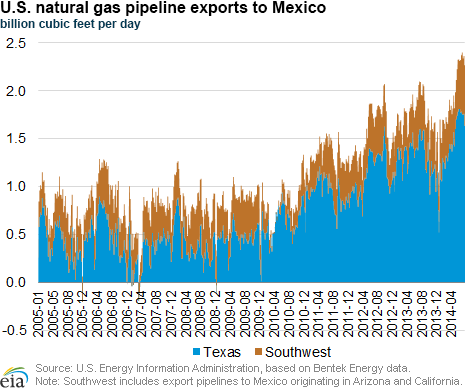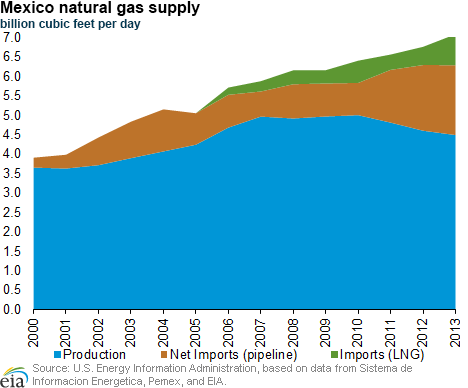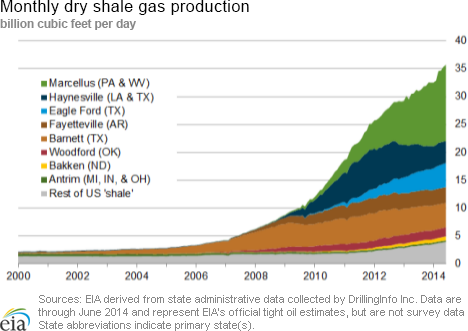In the News:
U.S. Gas Exports to Mexico Post Record High, with Further Gains Expected
U.S. natural gas exports to Mexico reached a record high of 2.5 billion cubic feet per day (Bcf/d) on July 24, averaging 2.3 Bcf/d from June through August and more than doubling since 2010. This growth is led by higher natural gas demand from Mexico's industrial and electric power sectors, relatively flat Mexican production, expansions in export pipelines from the United States and in Mexican pipeline infrastructure, and availability of natural gas supply from the United States. Mexico's national energy ministry projects that U.S. natural gas exports to Mexico will double in the next five years, driven primarily by Mexico's growth in gas-fired power generation.
Mexico's demand for natural gas has been growing rapidly in recent years, rising from 5.0 Bcf/d in 2005 to 6.9 Bcf/d in 2013, with the power generation sector accounting for 76% of that growth. From 2000 to 2013, the power generation share of total natural gas consumption has almost doubled, from 24% to 47%, and in the past three years (2011-13), all of the natural gas demand increase (0.5 Bcf/d) came from the power generation sector. The energy ministry projects natural gas demand growth of 4.7 Bcf/d between 2012 and 2027, with the power generation sector accounting for 73% (3.5 Bcf/d) of that growth.
Mexico's domestic production, which contributed 84% of Mexico's total supply in 2005, has been relatively flat and has not kept pace with rapidly growing demand, accounting for only 63% of total supply in 2013. Despite Mexico's large shale and tight resource base, its production is modest compared with the United States and Canada. Recent energy reforms in Mexico may boost production, although much of any new exploration may target higher–valued oil resources.
Growing natural gas demand in Mexico provides an outlet for increasing U.S. natural gas production, particularly from Texas's Eagle Ford Shale. In 2013, pipeline export capacity to Mexico from the United States was 4.2 Bcf/d. In the past two years, however, five export pipeline expansions in Texas and Arizona came online, increasing U.S. export capacity by 1.4 Bcf/d. Two more projects, totaling 2.3 Bcf/d, are scheduled to come online by the end of 2014. These include the NET Mexico expansion from the Agua Dulce Hub to near Rio Grand City, which will connect Eagle Ford to the Los Ramones pipeline and add 2.1 Bcf/d of export capacity. In addition, there is Kinder Morgan's new Sierrita Pipeline in Arizona, which will have an initial capacity of 0.2 Bcf/d, expandable to 0.8 Bcf/d by 2016.
Additional export projects have been recently announced, including Energy Transfer Partners's Houston Pipe Line and Oasis Pipeline facilities (together, 0.9 Bcf/d) and Colombia Pipeline (1.1 Bcf/d), which is a unit of Howard Midstream Energy Partners of San Antonio.
Mexico's domestic natural gas pipeline network is also undergoing major expansion. In the past two years, 2.8 Bcf/d of new pipeline capacity has been put into service, primarily to accommodate the expanding natural gas imports from the United States and the growth in electric power generation. An additional 5 Bcf/d capacity is scheduled to be added to the Mexico grid by the end of 2014. By 2016, a further 2.2 Bcf/d of new natural gas pipeline capacity is scheduled to come online, bringing the total 2013-16 capacity additions to 10 Bcf/d.
Overview:
(For the Week Ending Wednesday, August 6, 2014)
- Natural gas prices generally increased at most market locations this report week (Wednesday, July 30—Wednesday, August 6). The Henry Hub spot price increased from $3.76 per million British thermal units (MMBtu) last Wednesday to $3.89 yesterday.
- At the New York Mercantile Exchange (Nymex), the price of the near-month futures contract (August 2014) increased from $3.786/MMBtu last Wednesday to $3.933/MMBtu yesterday.
- Working natural gas in storage rose to 2,389 Bcf as of Friday, August 1, according to the U.S. Energy Information Administration (EIA) Weekly Natural Gas Storage Report (WNGSR). A net increase in storage of 82 Bcf for the week resulted in storage levels 18.4% below year-ago levels and 20.3% below the five-year average for this week.
- The Baker Hughes rotary rig count increased by 6 to 1,889 active units this week. Natural gas rigs decreased by 5 to 313, while oil rigs increased by 11 to 1,573. Gas rigs are 75 units below the year-ago level, and oil rigs are 185 units greater than last year's level.
- The average daily Mont Belvieu, Texas, natural gas plant liquids composite price for the week covering July 28—August 1 decreased by 14 cents/MMBtu (1.5%) to $9.47/MMBtu. A 3% decline in the price of propane led the overall decline. Natural gasoline fell by 1.5%, butane and isobutane fell by 1.1% and 1.4%, respectively, while ethane increased by 3%.
Prices/Demand/Supply:
Prices rise at most market locations this week. Natural gas prices rose across the board this week, but remained relatively low compared to about a month ago. The Henry Hub spot price rose from $3.76/MMBtu last Wednesday to $3.89/MMBtu yesterday, and most prices in the Gulf Coast area followed a similar pattern.
Northeast prices trade at strong discount to Henry Hub. Since around April, prices at most major Northeast locations have traded below the Henry Hub price. Prices at Texas Eastern M-3 (serving Pennsylvania and New Jersey), Transcontinental's Zone 6 (New York City), and Algonquin Citygate (Boston) have all traded $1/MMBtu or more below the Henry Hub price for most days over the past few weeks. Northeast prices usually spike above the Henry Hub in times of high demand in the winter, and until recently, usually traded at a premium even during the summer months. The combination of increased production in the Northeast, a mild summer, and new infrastructure has likely led to changes in price dynamics this year. This week, Transcontinental's Zone 6 prices rose from $2.24/MMBtu to $2.67/MMBtu; Texas Eastern M-3 prices rose from $2.22/MMBtu to $2.57/MMBtu; and Algonquin prices fell from $2.95/MMBtu to $2.85/MMBtu.
Prices rise at the Nymex. The price of the near-month (September 2014) contract rose from $3.786/MMBtu last week to $3.933/MMBtu yesterday. The 12-month strip (the average of the 12 contracts between September 2014 and August 2015) rose from $3.863/MMBtu to $4.023/MMBtu.
Supply increases slightly. Dry production remained flat week over week, but is 5.2% greater than it was the same time last year. Canadian imports increased 7.9% this week, with the largest volumetric increases going to the West and Midwest. LNG imports remained at minimal levels.
Demand declines. Total consumption fell 2.6% this week, with decreases across all major sectors. Consumption of natural gas for power generation declined 3%, as temperatures this week were both cooler than last week and cooler than normal. Industrial consumption declined slightly, and exports to Mexico fell by 9.8%.
Storage
Net injections in storage decline for the fourth week in a row. The net injection reported for the week ending August 1 was 82 Bcf, 33 Bcf larger than the five-year average net injection of 49 Bcf and 8 Bcf smaller than last year's net injection of 90 Bcf. Working gas inventories totaled 2,389 Bcf, 538 Bcf (18.4%) less than last year at this time and 608 Bcf (20.3%) below the five-year (2009-13) average.
Storage build is lower than market expectations. Market expectations called for a build of 84 Bcf. When the EIA storage report was released at 10:30 a.m., the price for the September natural gas futures contract fell 1 cent to $3.96/MMBtu on the Nymex.
From the week ending on April 4 through the week ending on August 1, net storage injections have totaled 1,567 Bcf versus 1,227 Bcf for the same 18 weeks in 2013, and 1,183 Bcf for these weeks between 2009 and 2013, on average. The average unit value of what storage holders put into storage from April 4 to August 1 was $4.45/MMBtu, 15% higher than the average value for the same 18 weeks last year of $3.88/MMBtu. The highest winter-month Nymex price (for the January 2015 contract) in trading for the week ending on August 1 averaged $4.02/MMBtu. This is 23 cents more than the front month Nymex contract price for that week (the August 2014 contract through the July 29 trade date, and the September 2014 contract starting on the July 30 trade date). A year ago, the difference was 38 cents/MMBtu, providing a bit more financial incentive to buy and store gas in the summer for sale in the winter.
There are currently 13 more weeks in the injection season, which traditionally occurs April 1 through October 31, although in many years injections continue into November. EIA forecasts that the end-of-October working natural gas inventory level will be 3,431 Bcf, which, as of August 1, would require an average injection of 80 Bcf per week through the end of October. EIA's forecast for the end-of-October inventory levels are below the five-year (2009-13) average peak storage value of 3,851 Bcf. To reach the five-year average peak value, average weekly injections through the end of October would need to be 112 Bcf.
Two of the three regions post larger-than-average builds. The East, West, and Producing regions had net injections of 62 Bcf (18 Bcf larger than its five-year average injection), 6 Bcf (1 Bcf smaller than its five-year average), and 14 Bcf (14 Bcf larger than its five-year average), respectively. Storage levels for all three regions remain below their year-ago and 5-year average levels.
Cooler temperatures during the storage report week support larger-than-average build. Temperatures in the Lower 48 states averaged 74.1 degrees for the week, 1.3 degrees cooler than the 30-year normal temperature and 1.7 degrees warmer than during the same period last year.
See also:
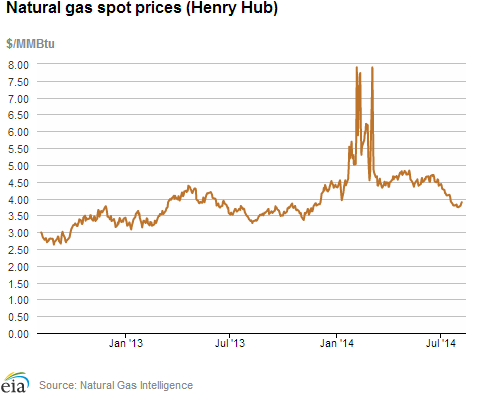
| Spot Prices ($/MMBtu) | Thu, 31-Jul |
Fri, 01-Aug |
Mon, 04-Aug |
Tue, 05-Aug |
Wed, 06-Aug |
|---|---|---|---|---|---|
| Henry Hub |
3.74 |
3.75 |
3.79 |
3.85 |
3.89 |
| New York |
2.27 |
2.17 |
2.84 |
2.70 |
2.67 |
| Chicago |
3.76 |
3.79 |
3.86 |
3.95 |
3.96 |
| Cal. Comp. Avg,* |
4.19 |
4.17 |
4.17 |
4.21 |
4.21 |
| Futures ($/MMBtu) | |||||
| September Contract |
3.841 |
3.798 |
3.834 |
3.897 |
3.933 |
| October Contract |
3.867 |
3.822 |
3.859 |
3.920 |
3.867 |
| *Avg. of NGI's reported prices for: Malin, PG&E citygate, and Southern California Border Avg. | |||||
| Source: NGI's Daily Gas Price Index | |||||
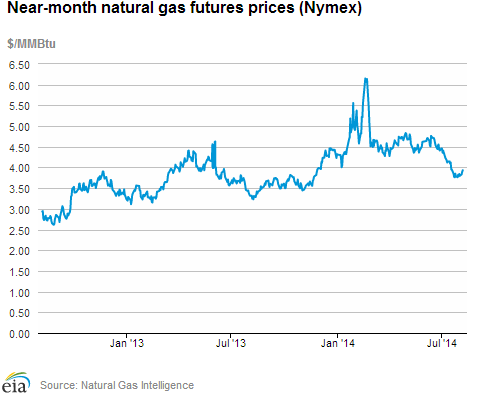
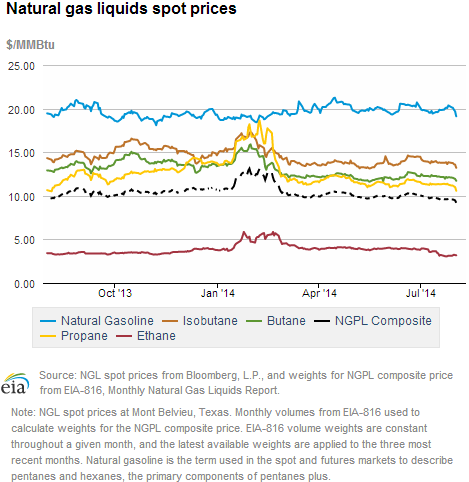
| U.S. Natural Gas Supply - Gas Week: (7/30/14 - 8/6/14) | ||
|---|---|---|
Percent change for week compared with: |
||
last year |
last week |
|
| Gross Production | 5.23%
|
0.03%
|
| Dry Production | 5.18%
|
0.03%
|
| Canadian Imports | 5.99%
|
7.91%
|
| West (Net) | -6.48%
|
9.90%
|
| MidWest (Net) | 28.90%
|
10.77%
|
| Northeast (Net) | 121.95%
|
127.10%
|
| LNG Imports | -71.19%
|
-47.25%
|
| Total Supply | 4.92%
|
0.44%
|
| Source: BENTEK Energy LLC | ||
| U.S. Consumption - Gas Week: (7/30/14 - 8/6/14) | ||
|---|---|---|
Percent change for week compared with: |
||
last year |
last week |
|
| U.S. Consumption | 0.7%
|
-2.3%
|
| Power | -0.3%
|
-3.0%
|
| Industrial | -0.2%
|
-0.1%
|
| Residential/Commercial | 5.2%
|
-4.0%
|
| Total Demand | 0.8%
|
-2.6%
|
| Source: BENTEK Energy LLC | ||
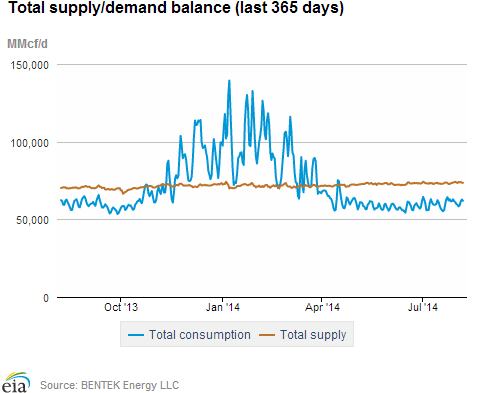
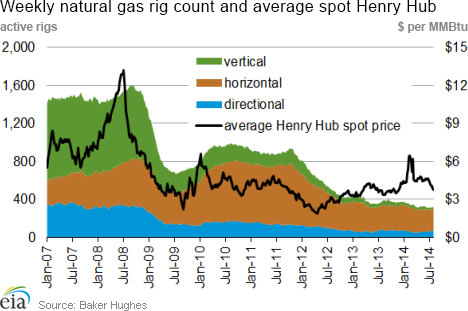
| Rigs | |||
|---|---|---|---|
Fri, August 01, 2014 |
Change from |
||
last week |
last year |
||
| Oil Rigs | 1,573 |
0.70% |
13.33% |
| Natural Gas Rigs | 313 |
-1.57% |
-19.33% |
| Miscellaneous | 3 |
0.00% |
-50.00% |
| Rig Numbers by Type | |||
|---|---|---|---|
Fri, August 01, 2014 |
Change from |
||
last week |
last year |
||
| Vertical | 373 |
3.32% |
-13.66% |
| Horizontal | 1,298 |
0.39% |
20.97% |
| Directional | 218 |
-4.80% |
-21.30% |
| Source: Baker Hughes Inc. | |||
| Working Gas in Underground Storage | ||||
|---|---|---|---|---|
Stocks billion cubic feet (bcf) |
||||
| Region | 2014-08-01 |
2014-07-25 |
change |
|
| East | 1,219 |
1,157 |
62 |
|
| West | 387 |
381 |
6 |
|
| Producing | 783 |
769 |
14 |
|
| Total | 2,389 |
2,307 |
82 |
|
| Source: U.S. Energy Information Administration | ||||
| Working Gas in Underground Storage | |||||
|---|---|---|---|---|---|
Historical Comparisons |
|||||
Year ago (8/1/13) |
5-year average (2009-2013) |
||||
| Region | Stocks (Bcf) |
% change |
Stocks (Bcf) |
% change |
|
| East | 1,400 |
-12.9 |
1,503 |
-18.9 |
|
| West | 481 |
-19.5 |
460 |
-15.9 |
|
| Producing | 1,047 |
-25.2 |
1,035 |
-24.3 |
|
| Total | 2,927 |
-18.4 |
2,997 |
-20.3 |
|
| Source: U.S. Energy Information Administration | |||||
| Temperature -- Heating & Cooling Degree Days (week ending Jul 31) | ||||||||
|---|---|---|---|---|---|---|---|---|
HDD deviation from: |
CDD deviation from: |
|||||||
| Region | HDD Current |
normal |
last year |
CDD Current |
normal |
last year |
||
| New England | 2
|
-1
|
-2
|
28
|
-17
|
-2
|
||
| Middle Atlantic | 4
|
1
|
0
|
41
|
-18
|
1
|
||
| E N Central | 13
|
9
|
-8
|
28
|
-29
|
11
|
||
| W N Central | 5
|
2
|
-11
|
50
|
-22
|
21
|
||
| South Atlantic | 0
|
0
|
0
|
88
|
-9
|
5
|
||
| E S Central | 2
|
2
|
1
|
68
|
-27
|
2
|
||
| W S Central | 0
|
0
|
0
|
120
|
-6
|
-5
|
||
| Mountain | 1
|
-2
|
0
|
90
|
11
|
6
|
||
| Pacific | 0
|
-2
|
0
|
82
|
34
|
33
|
||
| United States | 4
|
2
|
-3
|
68
|
-7
|
9
|
||
|
Note: HDD = heating degree-day; CDD = cooling degree-day Source: National Oceanic and Atmospheric Administration | ||||||||
Average temperature (°F)
7-Day Mean ending Jul 31, 2014
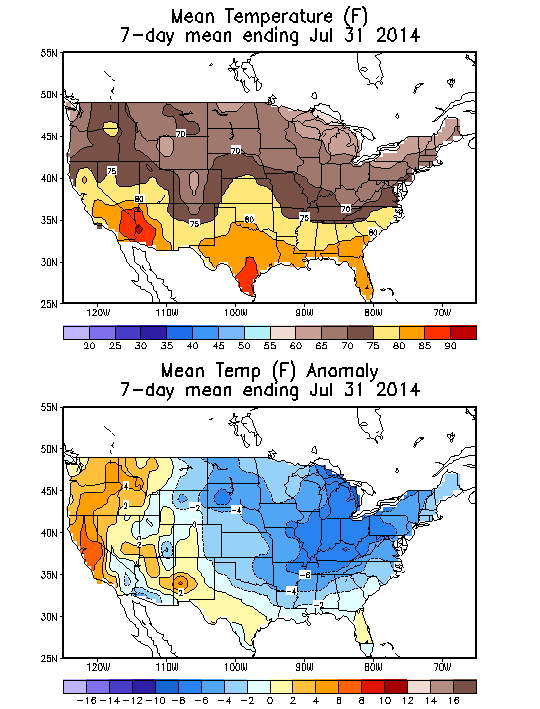
Source: NOAA/National Weather Service
Deviation between average and normal (°F)
7-Day Mean ending Jul 31, 2014

Source: NOAA/National Weather Service

